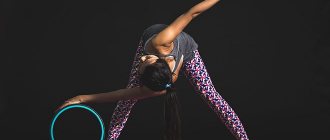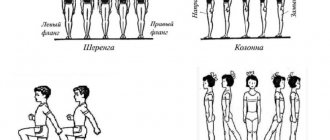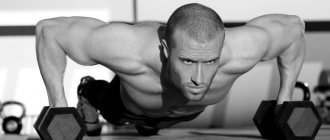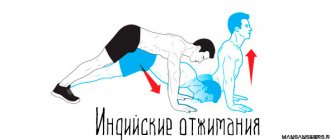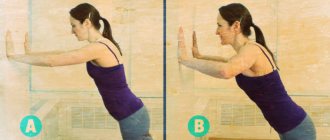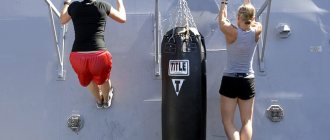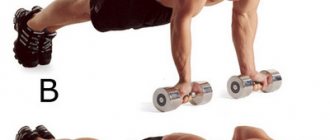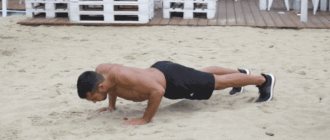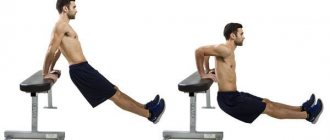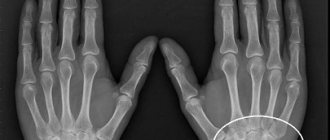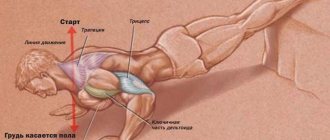Monday
Monday is a hard day. Therefore, I also decided not to relax too much and do a harder lesson that day. As always, we start only after the warm-up.
- The first will be standard pull-ups, that is, a straight grip, hands shoulder-width apart;
- Next are the parallel bars - push-ups on the chest, that is, the torso is tilted forward a little, about 10 degrees, and in the process we move the elbows to the sides. But in the photo you can see the correct execution of this exercise;
- Again the horizontal bar - pull-ups behind the head, that is, hands about 2 shoulder-width apart, at the top point we touch the crossbar with the back of the head;
- We lie down on the floor and do regular push-ups, hands slightly wider than shoulder-width apart;
- Again the horizontal bar, but this time we work on the abs - we raise our legs while hanging;
- The last one is parallel bars, and also on the press. That is, on the uneven bars, we raise our legs - you can do it with straight arms, which is better, you can rest on your forearms.
Horizontal bar in the doorway
Such projectiles are in demand because they are easy to install and inexpensive. With their help you can perform almost all types of pull-ups. Crossbars for doorways are divided into three types.
Spacer (sliding)
The horizontal bar is a metal pipe with spacers coming out of one or both ends. The width of the crossbar varies from 800 to 1300 mm. The simulator is usually installed between two walls, but can also be used in door frames. Reliable fixation is ensured by pressing spacers into the surface and additional fastening plates pressed to the wall with dowel screws.
https://youtu.be/EbRCrQBUVBk
The main advantages are accessibility and ease of use. In addition, a lot of additional equipment is produced for spacer horizontal bars: boxing bags, gymnastic rings, expanders for pulling up.
Thanks to the reliable fastening, you can even hang a children's swing on the crossbar or attach TRX loops.
The disadvantages include mechanical damage to the wall or doorway.
https://youtu.be/lrryterjwQs
When purchasing a projectile for home use, pay attention to the quality of the metal and welds. Ask the seller about the permissible weight values for the horizontal bar you have chosen. We also recommend purchasing exercise equipment that has a non-slip coating (rubber, neoprene).
Price examples: “Atemi ADB-01” – 845 rubles, “Health Formula” – 660 rubles, “Shantou Gepai T74386” – 670 rubles.
Removable horizontal bar
This pull-up bar has a prefabricated structure consisting of a short supporting part, a long working part and two arcs connecting everything together. The simulator is mounted in the doorway so that the supporting part presses on the wall and the horizontal frame of the frame, and the working part rests on the other side against the vertical slopes. This fastening method allows you to securely fix the horizontal bar.
The main advantage is convenience - the exercise machine is instantly installed in the doorway, and then just as quickly put away in the closet. The removable horizontal bar, thanks to neoprene linings, does not damage the wall and jambs.
The presence of two horizontal handles, allowing you to perform narrow pull-ups, can also be considered a plus. In addition, the apparatus can be placed on the floor and used as a support for push-ups.
https://youtu.be/ulpWcOHiBSM
Since the removable crossbar is installed in the doorway, the athlete is deprived of the opportunity to do some amplitude exercises, for example, lateral twisting of the body in a hanging position. This is perhaps the only disadvantage of the simulator. The projectile is sold unassembled; when purchasing, check the completeness.
Price examples: “Bradex” – 880 rubles, “Workout H3D” – 1500 rubles, “Absolute Champion” – 1700 rubles.
Above-door horizontal bar
All-welded structure consisting of a crossbar and mounting stops. Installed above the doorway by fixing with anchor bolts. The crossbar itself is at a distance of 15–20 cm from the wall. There are models with additional handles for different grips. Thanks to its reliable installation, the exercise machine is suitable even for overweight people.
The advantages of the over-the-door horizontal bar include the ability to perform most types of pull-ups, as well as use together with additional accessories (rings, TRX slings, expanders, etc.).
The height of the projectile attachment allows you not to bend your legs during the exercise, which increases comfort and partially saves the athlete’s energy.
https://youtu.be/c2otcgrjnyk
The disadvantages of the over-door horizontal bar are the non-removable structure, the need to drill into the wall for installation, and the inability to perform amplitude lateral movements. When choosing in a store, check the quality of welding of the seams. If your weight exceeds 85–90 kg, we recommend purchasing an over-door crossbar with reinforced fastenings.
Price examples: “Plastep” – 930 rubles, “Borabo” – 1800 rubles, “SV Sport” – 2600 rubles.
Pull-ups and push-ups. Pull-ups: technique of execution
Don’t forget that the key to success is not only the amount of time spent on exercises, but also the quality of their implementation.
- Start every workout with a warm-up.
- Warm up your lower back thoroughly by bending over.
- In any of the listed exercises, while inhaling, we lower ourselves, and while exhaling, we pull ourselves up.
- It is important to ensure that your back is straight.
- Try to load your back as little as possible; all pull-ups should be done using the strength of your arms and abs.
- Do not swing your body during exercises, this will significantly reduce the load and, therefore, efficiency.
- To prevent your arms from getting tired quickly, use special straps.
- Gradually increase the number of repetitions and complicate the exercises themselves.
- The break between sets should be at least 30 seconds, maximum 2 minutes.
- Don't forget that your workouts should be regular: start with 2-3 workouts a week, with a rest day in between.
If you want to pump up beautiful abs, then you should work hard. But don’t limit yourself to doing planks or push-ups within four walls: feel free to go outside, fresh air and bright sun will additionally motivate you to achieve results faster! A horizontal bar can be found in almost any yard or gym, so don’t put off your dream of a toned body and get to work.
Pull-ups require more effort than push-ups, so proper form is usually more difficult to perform. Without sufficient strength in their arms and back, people involuntarily begin to help themselves by jerking and swinging, using their legs, and do not lift their body enough. As a result, the wrong technique takes root, and the muscles of the back and arms do not receive sufficient load, and training is wasted.
Push-ups, pull-ups, squats, jumping rope and most other exercises have one fundamental thing in common: they give noticeable positive dynamics and effect only when performed correctly. By neglecting technology, a person robs himself, exchanging precious time and effort for trivial results.
Starting position when pulling up:
- The palms tightly grip the horizontal bar using one of the grip options. Arms are fully straightened. The abs are tense. Legs crossed. The body hangs freely on the horizontal bar.
- Grips. With a straight grip, the palms are directed outward in relation to the face, the main load goes to the middle part of the latissimus muscle, the anterior serratus and triceps. With a reverse grip, the palms are directed towards the face, the load falls on the lower part of the latissimus muscle and biceps. A wide grip shifts the main force to the back, a narrow grip to the chest muscles, and a medium grip to distribute the force evenly.
Performance:
- Using the strength of your arms and back, smoothly lift your torso up, without jerking your body or jerking your legs. Touch the bar with your upper chest, fix your body for one or two seconds and smoothly, but without relaxing your muscles, lower your body to the starting position. Elbows should not rise above the horizontal bar.
- Breath. Inhale when lifting the body, exhale when the body lowers.
How to pump up your triceps?
The horizontal bar can easily replace the parallel bars. Thus, by performing various variations of push-ups on it, which will be discussed further, you can pump up your triceps.
Regular grip on the horizontal bar
This exercise involves placing your hands slightly wider than shoulder width, with your palms facing outward. Bend your legs as you rise, exhale. Take a breath as you descend. Try, again, to engage the triceps in the work, and not just lift with your whole body. When bending, the load is even greater. It will be difficult, but try.
Start with 3 sets of 8-10 repetitions. In the future, no one limits you to do more, but only everything is proportionate.
Narrow grip on the horizontal bar
Nothing has changed here that was in the reverse narrow grip, only the palms “look” outward. The palms should be brought together at one point. This exercise also puts stress on the chest, but still, it pumps up the triceps more than the pecs.
Bend your legs and bend your arms so that your chin is higher than the bar. Exhale on the way up, inhale on the way down. This grip is somewhat dangerous and should not be done quickly to avoid sprains.
The optimal load to start with is 3 sets of 8-10 repetitions. For beginners, 5-8 is possible.
Close-grip push-ups
Starting position: stand with outstretched arms on the apparatus. Hands are narrower than shoulder width. As you inhale, bending your elbows, lower yourself onto the horizontal bar and touch it to your upper abdomen. In the lower position, your elbows should be brought back. As you exhale, straighten your arms, rising to the starting position.
In this exercise we pump up the pectoral muscles and triceps. I recommend doing 3 sets of 12-15 reps minimum.
Wide grip push-ups
https://youtu.be/tk0OPNxPsts
This exercise is similar to the previous one, but we place our hands wider than our shoulders and at the lowest point we spread our elbows to the sides. We try to touch the bar to the bottom of the chest.
This is a rather complex exercise, but very effective for pumping up the “undercut” - the lower chest, and will also involve the muscles of the back and triceps.
I recommend doing 3 sets of 6-8 repetitions. Beginners are unlikely to succeed. More experienced and trained ones can increase the number of repetitions to 10-12.
Tuesday
The lesson will be easy compared to Monday, since the muscles should have time to recover. Otherwise, you will get the effect of catabolism, that is, when you train and train, but muscle mass not only does not increase, but even decreases.
- Let's start with push-ups - place your hands shoulder-width apart;
- We continue with push-ups, only this time spread your arms as wide as possible;
- And the last push-ups for today are with a narrow grip. That is, place your palms on top of each other.
Look at the photo so that the similar position is correct - this is important
- Now lie on your back and raise your legs - working on your abs;
- Also, lying on your back, do a bicycle - the movements characteristic of pedaling. By the way, the socks here should also work as if there were actually pedals under your feet - this is the correct execution;
- Let's finish the easy day with simple abdominal crunches. Of course, for greater efficiency, I would recommend doing them with lateral turns of the torso, so that the oblique abdominal muscles are also involved
Table of push-ups and pull-ups. Reverse and forward progression method
Sculpted abs are the dream of both men and women, both bodybuilders and fitness enthusiasts. Whether you're an athlete or just want to get your body ready for beach season, working on your abdominal muscles is definitely something you should do. And in order not to do planks, push-ups and crunches inside four walls, go outside and find a horizontal bar, because training in the fresh air is good not only for your health, but also for your mood. However, we warn you right away - it won’t be easy, but the result is worth the effort.
By the way, an important advantage of swinging the press on a horizontal bar over the same plank or push-ups is that the result on this apparatus is achieved faster and can be visible after just a few exercises. The specificity of the horizontal bar requires the athlete to make a lot of effort to lift and hold the entire body above the ground, but thanks to this, the body acts as an excellent weight, which increases the effectiveness of the exercise and affects almost all muscles.
During exercises on the horizontal bar, the following muscles are included in the work:
- rectus abdominis muscle;
- trapezius muscles;
- deltoid muscles;
- triceps brachii;
- pectoralis major muscles;
- oblique and transverse abdominal muscles;
- back muscles;
- anterior thigh muscle group;
- muscles of the back of the thigh;
- small and medium gluteal muscles.
m
This table of pull-ups on the horizontal bar will help you achieve the desired result; you will be able to do at least 25 pull-ups.
Reverse progression method
You need to do pull-ups for 6 days; on the 7th, be sure to take a break from physical activity. You need to practice for 4 weeks, constantly changing your grip. In week 5, continue the training program using the direct progression method. Then you should return to the first version of the program.
Method diagram in table form
The presented training program is designed for beginners; in 5 weeks you can easily reach 25 times in 3 approaches. Those who have a standard significantly higher than the presented amount can catch up by doubling all the numbers in the table. This way you can learn to do it 30, 50 and 100 times, the main thing is desire and regular training.
There are two types of grip in pull-ups - forward and reverse.
With a direct grip, the fingers of the hands move away from you, with a reverse grip, they move towards you. If the hands are located at shoulder level - a narrow grip, 10 cm wider - medium, and if they are spread as far apart as possible - a wide grip.
Thursday
After a day of rest, I’m sure you will have enough strength and energy for more workload.
- Let's start with the horizontal bar and work on the biceps - pull-ups with a reverse grip, hands shoulder-width apart; We will do push-ups on parallel bars, focusing on the triceps. That is, in the process, the arms are pressed to the body, and even try to tilt the body back a little, for greater effect;
- Let's go back to the crossbar. We will do pull-ups with a reverse grip, that is, the palms are facing you, and the width of the arms is extremely narrow - no more than a fist;
- Let's complicate the push-ups - today the same standard ones, from the floor, with hands shoulder-width apart, but on fists;
- We will pump the abs in the same way on the bar, but today by raising the knees to the shoulders. That is, in essence, reverse crunches while hanging;
- Let's finish with the familiar leg raises on the uneven bars from Monday.
How to pump up biceps on the horizontal bar?
https://youtu.be/Ys6z5jbt8sQ
Using the horizontal bar, you can pump up your biceps in such a way that when you pull yourself up, you lift a weight equal to your own weight. This is not at all dangerous and is very easy to do. There are several grips, all are effective, tested from personal experience, but it’s worth the effort.
Reverse grip
This exercise requires your hands to hold the bar shoulder-width apart with your palms facing inward. To avoid the formation of calluses, wear gloves with fingers shortened by half.
Bend your legs, rise, exhale. Inhale as you lower. The chin is above the bar. Try not only to lift your body, but also make your biceps work. Thus, the load goes specifically to the biceps muscles, which leads to their development.
This exercise is initially performed like this: 3-4 sets of 10-12 repetitions. Depending on your capabilities, the load can be increased.
Reverse close grip
An equally effective exercise for both growing biceps and strengthening your hands. This grip provides for the following arrangement of the palms on the bar: the edges of the palms should be as close to each other as possible, it is even better if they are brought together. Again, bend your legs, rise, exhale. As you descend, take a breath. The chin, again, is higher than the bar.
https://youtu.be/_IsvTu-mom8
The bottom line is that closed palms and muscles located close to each other receive more load. Therefore, it has a beneficial effect on biceps growth. It should also be performed in 3-4 sets of 8-10 repetitions.
Pull-ups or push-ups: which is better?
Pull-ups and push-ups are the most basic exercises. Every athlete began his journey with these exercises. And any professional athlete will say that these are the best exercises for a beginner and this is where you should start your journey in sports.
Push ups
Push-ups begin to be taught in physical education classes in kindergarten. And this continues further at school and in college.
Push-ups help strengthen your entire body.
Of course, each individual muscle works, to one degree or another. And the load can be varied. Achieving great results is quite simple. After all, no additions are needed.
Pull-ups
It is also a basic exercise and is included in the physical education curriculum. To perform this, you need a horizontal bar, which can be found on any sports ground.
Of course, this is not a complete list, because many more muscles are indirectly involved in the work.
Pull-ups require more skill and strength than push-ups. But this only adds advantages to it.
Where to begin?
You can argue about the merits of these exercises for a long time. Each of them has its pros and cons.
In push-ups, it is the chest muscles that work to a greater extent. By changing the position of your hands you can achieve more work. The remaining muscles work as auxiliary muscles. The main advantage, of course, is that there is no need for additional equipment and equipment.
When doing pull-ups, the back muscles receive the main load. And by also changing the position of the hands and grips, the load can be shifted to the hands. To perform pull-ups, you need a horizontal bar, which can cause some difficulties.
Of course, if we assume that the training will take place at home, then push-ups are the best exercise. If you train outside, then, of course, it’s worth conquering the horizontal bar.
In order to achieve greater results and increase your performance in both strength and muscle volume, it will be better to combine these exercises. This will help you work out your entire upper body better.
To begin with, you can divide your workouts by day. Do pull-ups one day, push-ups the other. As the muscles get used to the load, each time the workouts will seem easier and easier.
Next, you should try doing two exercises in one day. There are options here too. For example, do push-ups in the morning and pull-ups in the evening, or vice versa. You can do this in one workout. You should try to perform the exercises one after another in one approach. Or do a few sets of push-ups, then a few sets of pull-ups.
There are enough options to choose from. And if you come up with something new every time, it will diversify your training. The main thing is not to let the body muscles get used to the same load, but to constantly vary it. You should also add squats to your workouts in the future. This will help to finally consolidate the result and work out the whole body.
Bars or push-ups. Push-ups from the floor and on parallel bars.
I want to devote this article to dips and push-ups. First of all, I would like to write about how to learn to do push-ups on uneven bars.
To begin with, you should just try to do push-ups at least once, so to speak, test your strength, in case it won’t be too difficult for you.
If you can do push-ups at least a couple of times, that’s very good; you can say that not all is lost.
But, there is one rule in push-ups on the uneven bars; only those push-ups are considered correct - when your arms are bent 90 degrees at the elbow.
Something like this:
muscle dips
The photo shows which muscles are pumped best. The greatest load is placed on the chest and triceps. Therefore, these are exactly the muscle groups that you can pump up during dips.
If everything is very bad for you and you cannot do push-ups on the uneven bars, then you need to start training not with the uneven bars, but with regular push-ups from the floor. They are naturally much easier than on uneven bars, the result is not so great, but if you perform push-ups with full amplitude, then the effect is also very good, no worse than uneven bars. Therefore, for the first time, I advise you to simply do push-ups from the floor, about 50-100 times per workout, divided into about 5-10 approaches, whichever is more convenient for you.
Keep the interval short, about 1-2 minutes. Try to do push-ups correctly and lower yourself almost to the floor. You should place your hands slightly wider than your shoulders, so the load will be more on the chest; if you place your hands closer to each other, the maximum load will be on the triceps. You can combine as you think best, some want beautiful sculpted breasts, others vice versa. So see for yourself.
Here is an approximate diagram for push-ups from the floor, the more the better:
pushups
In dips, I advise you to do about 100-200 repetitions; I personally did up to about 200 push-ups per workout. I tried to break push-ups into a minimum number of repetitions, this way I trained endurance, and the effect of the training was greater.
Simply - simply, you squeeze out the maximum and thus the muscles are pumped better, more cells in the muscles are torn. But if you are a beginner, about 80-100 push-ups will be enough for you. Try to do as I did, break the repetitions into a minimum number of approaches, I think 7-8 approaches is enough for you to start with. And don’t forget to look at the quality of the push-ups; remember that correct push-ups are considered when the arm at the elbow is bent 90 degrees. The more you go down, the better your muscles will be!
Well, I'm good at push-ups. There is nothing complicated, you just need patience. And I assure you, the result will not keep you waiting!
Friday
After yesterday's load, it would be logical to conduct an easy lesson, which is what we will do.
- Let's start with standard push-ups, arms width - shoulders;
- The next push-ups are essentially the same, only, firstly, already on the fists, and secondly, the elbows should not leave the body during the process;
- The third push-ups for today are narrow. Place your palms on top of each other so that they form something like a rhombus;
- Press – we perform crunches, but only with torso turns to the sides to pump up the oblique abdominal muscles;
- We also raise our legs while lying down - the lower abs also require attention;
- We end the week with simple crunches all the way.
As you can see, everything is quite doable, and the effectiveness, believe me, is extremely high. Of course, it will not be possible to replace basic exercises with a barbell with a sports ground alone. But our goals are somewhat different - we are not chasing the title “Mr. Olympia”, but simply want a beautiful, toned, athletic, moderately pumped, strong body. Finally, watch a relaxing video of training on the uneven bars and horizontal bar. Don't be lazy, get busy. See you soon.
Alexander Bely
Push-up pattern, pull-up pattern. Pull-up and push-up programs
The horizontal bar is one of the simplest, most accessible and effective equipment for those who want to improve their physical fitness on their own. The correct pull-up technique on the horizontal bar will help you work out a whole group of muscles, from the back to the abs.
If doing pull-ups a couple of times on the horizontal bar is no longer a problem for you, then you can move on to the next stage - increasing the number of pull-ups. Stick with this regimen for thirty weeks, and you are guaranteed to be able to do 30 pull-ups, and possibly more. It all depends on your desire. Exercise on the horizontal bar 6 days a week, make the seventh a day off. Rest between pull-ups for 2-3 minutes.
Benefits of pull-ups
Pull-ups are especially useful for problems with the spine and weak back muscles; it perfectly develops and strengthens them. The basis of success is the correct execution technique.
An exercise such as pull-ups on a horizontal bar has been familiar to everyone since school days. In addition, it is popular among both many professional athletes and amateurs who simply want to stay in good shape.
By performing it regularly and correctly, you can significantly develop the muscles of your back and upper shoulder girdle, improve your body contour and increase your grip strength. One of the basic features of this exercise is that it is based on working with your own weight.
This exercise has a beneficial effect on the body of almost everyone, but it will be especially useful for those who have back problems. They may be caused by scoliosis or spinal injuries. But you need to remember that the technique of execution is of great importance, then the exercises will only bring benefits, and the result will be visible quite soon.
Exercises for the press on the horizontal bar
The 007-201 apparatus is a cascade of three bars, 2 of them are intended for pull-ups, and the other, the lowest, is for push-ups. 4 vertical posts and 3 horizontal crossbars - that’s all the “spare parts” of this projectile. However, the functionality of the equipment allows you to perform a huge variety of exercises both for workout and standard physical education at school.
The support pillars are of different heights - from 500 to 1500 mm. 3 crossbars are located at a height of 400,900 and 1400 mm respectively. A steel clamp is used to fasten the elements, which allows you to adjust the height of each crossbar to the height of the athlete. A special anti-corrosion coating provides the push-up and pull-up bars with strength and durability of the steel in all weather conditions.
The overall dimensions of the cascade of crossbars 007-201 are 4000x160x1500 mm.
Pull-ups, at first glance, are a simple “yard” exercise. However, trained athletes are aware that this element has impressive potential and is capable of:
- increase strength, mass and endurance;
- strengthen the muscles of the wrists and hands;
- increase grip strength (important for weightlifters);
- improve relief;
- optimize the activity of the cardiovascular system.
And in general, this exercise can significantly improve the athlete’s physical fitness.
Strength training
When working on strength indicators, it is necessary to take into account the nuances of work in different phases - positive and negative. It’s quite easy to distinguish between them: the first involves raising the torso, and the second – lowering it. These points are closely related to the growth of size and strength.
So, in the first case, you can increase the characteristic by intensive work in the positive phase. This means that all ascents must be performed much slower than descents. In terms of time, it will look like this - 2-3 seconds to 1.
As for the number of approaches, they should not be more than 3-4 with 6-8 repetitions. If the body feels like it can do more, then you can work with weights. As a rule, these are metal pancakes that are attached to a special belt or vest. For a home workout, this could be as simple as a weighted backpack.
- Close grip pull-up.
The latissimus, pectoral and rhomboid muscles, rear delta, middle trapezius and triceps are pumped.
Technique:
- fixate on the crossbar, placing your hands slightly narrower than the outermost points of your shoulders;
- cross your legs and tense your abs;
- slowly raise your body until your chin crosses the line of the bar;
- freeze for 1-2 seconds;
- quickly return to IP.
This element can also be performed using a reverse grip or using elastic bands. In this case, the main load will fall on the biceps.
- Medium grip pull-up.
Great option for beginners. It evenly distributes the load on the back and biceps.
Technique:
- hang on the apparatus, placing your hands exactly above your shoulders;
- cross your legs and tense your abdominal muscles;
- smoothly raise your body, crossing the line of the bar with your chin;
- fixate for 1-2 seconds;
- sharply, but without jerking, return to the IP.
After carefully working out this element, you can move on to exercises with a narrow or wide grip.
- Gironde pull-ups.
This type deeply pumps the latissimus muscles.
Technique:
- fixate on the bar, placing your hands wider than your shoulders;
- cross your legs and tighten your abdominal muscles;
- smoothly pull the lower part of the pectoral muscles to the line of the crossbar;
- wait for 1-2 seconds;
- quickly return to IP.
Massive exercises
Increasing this characteristic using a horizontal bar is not much different from training in the gym. Here you will also need to work with weights. Another nuance is that pumping is in the negative phase. That is, a rapid ascent is replaced by a smooth slow descent. 2-3 rounds of 8-12 repetitions each are enough. With increased endurance, you can add weights (pancakes, weights).
- Wide grip pull-up.
The exercise is aimed at developing the latissimus and biceps brachii muscles.
Technique:
- grab the bar with a grip wider than shoulder-width;
- cross your feet and tense your abs;
- sharply pull your chin up to the line of the bar;
- fixate for 1-2 seconds;
- slowly return to IP.
Alternatively, you can use a reverse grip, but the number of sets and repetitions will remain the same - 4/5-6. If you have the opportunity to do more, you should think about working with cargo.
- Rocky pull-up.
The exercise is named after the famous hero played by Sylvester Stallone. This is what he used in the film in his training. This element is essentially a more complex version of the Gironde pull-up. Works well on the back, biceps and forearms.
Technique:
- fixate on the bar, placing your hands slightly wider than your shoulders;
- cross your feet and tense your abs;
- smoothly pull the lower part of the pectoral muscles to the line of the crossbar;
- fixate for 1-2 seconds;
- lower to the starting position;
- pull yourself up to the bar again so that it is behind your head;
- return to IP.
Just like the Gironde element, these exercises are only suitable for experienced athletes.
- Parallel grip pull-up.
Here you will need a special horizontal bar with parallel handles, which will allow you to pump your lower back, deltoids, brachialis, biceps and triceps.
Technique:
- hang on the apparatus, placing your hands parallel with a neutral grip;
- cross your feet, bend your elbows slightly, tighten your abdominal muscles;
- as you exhale, smoothly lift your body to the bar;
- fixate for 1-2 seconds;
- while inhaling, return to IP without jerking.
Number of approaches – 3-5 with 8-12 repetitions.
m
There are several exercises on the horizontal bar for pumping up the abs, let’s start with the most popular and simplest of them.
When lifting bent legs, the lateral and rectus abdominis muscles are most involved. If you are not very familiar with sports before, it may be difficult to immediately achieve the correct technique.
- Let's grab the bar so that our palms are shoulder-width apart.
- Bend your knees and pull them towards your chest.
- Straighten your legs so that they are parallel to the floor or slightly higher.
- Bend your legs again and press them to your chest.
- We lower our legs.
- We perform 3 sets of 10–12 lifts.
under
Raising straight legs while hanging on the horizontal bar
This is a classic version of this exercise. But it doesn’t matter if you can’t do it the first time, try simplifying the exercise a little.
- We take the crossbar with our hands.
- We bend our knees.
- With an exhalation we pull them to our chest.
- Inhaling, we lower our legs.
- Perform 10–15 pull-ups.
Raising your legs bent at the knees while hanging on the horizontal bar
The back should remain straight and not too stressed throughout the entire exercise. And breaks between approaches should not exceed 30–40 seconds. Perform all movements smoothly, without sudden jerks.
Program for Beginners
The first thing beginners need to do is learn how to do pull-ups technically correctly. Pull-ups are performed not by the biceps and forearms, but by the latissimus dorsi muscles. This is the basis on which all other exercises are built. The easiest way to do this is to try to bring your shoulder blades together as you lift your body up. No need to swing.
The pulling movement itself should be performed not due to some kind of impulse, but due to compression of the latissimus dorsi muscles. It is quite difficult to feel this movement, and often it takes more than one month of training. But when you learn to do this, your back will begin to grow at an enviable speed. Another option is to use straps, they help to “turn off” your arms.
Before you start performing the complexes, you need to do a test - do pull-ups with a wide grip for the maximum number of times. If you manage to do more than 5, skip the first program and immediately proceed to the second. If you manage to do 1-4 times, start with a simple 4-week program to increase the number of pull-ups:
| Week 1 | |
| Number of approaches | Number of repetitions |
| Day 1 | |
| 5 | 1, 1, 1, 1, maximum |
| Day 2 | |
| 5 | 1, 1, 1, 1, maximum |
| Day 3 | |
| 5 | 1, 2, 1, 1, maximum |
| Week 2 | |
| Number of approaches | Number of repetitions |
| Day 1 | |
| 5 | 1, 2, 1, 1, maximum |
| Day 2 | |
| 5 | 2, 2, 2, 1, maximum |
| Day 3 | |
| 5 | 2, 2, 2, 2, maximum |
| Week 3 | |
| Number of approaches | Number of repetitions |
| Day 1 | |
| 5 | 2, 3, 2, 2, maximum |
| Day 2 | |
| 5 | 3, 4, 3, 3, maximum |
| Day 3 | |
| 5 | 3, 4, 3, 3, maximum |
| Week 4 | |
| Number of approaches | Number of repetitions |
| Day 1 | |
| 5 | 3, 4, 3, 3, maximum |
| Day 2 | |
| 5 | 4, 5, 4, 4, maximum |
| Day 3 | |
| 5 | 4, 5, 5, 5, maximum |
The horizontal bar training program for those who were able to perform more than 5 pull-ups is designed for 3 sessions per week. Other exercises have already been added here. Each workout is quite short, no more than 30 minutes.
| Monday | ||
| "Jumping" pull-ups | 3x10-15 | |
| Horizontal pull-ups on a low bar | 3x10-12 | |
| Wide grip pull-ups | 3x5-7 | |
| Hanging on the horizontal bar | 4xmaximum | |
| Wednesday | ||
| Hanging leg raises to the bar | 3x8-10 | Makatserchyk - stock.adobe.com |
| "Janitors" | 3x6-8 | |
| Imitation of French press on a low bar | 4x10-15 | |
| Hanging on the horizontal bar | 4xmaximum | |
| Friday | ||
| "Jumping" pull-ups | 3x10-15 | |
| Head pull-ups | 3x5-7 | |
| Close-grip pull-ups | 3x4-6 | |
| Hanging on the horizontal bar | 4xmaximum |
Once you can complete the entire amount of work without much effort, begin to slowly increase the number of repetitions and approaches. Also, from time to time, measure your progress separately in pull-ups, because this is the basis of all exercises on the horizontal bar. If you can easily and technically perform 15 reps, it's time to move on to heavier training for more experienced athletes.
Another great option for increasing the load is to use additional weights. A backpack filled with something heavy, such as sandbags or water bottles, works well here.
https://youtu.be/dLjRPXKdZ6c
Outdoor horizontal bar training program for beginners
If you decide to take on yourself and turn your jelly-like body into a source of pride, understand a few principles for starting to work on your muscles. Beginner turnstiles often have a weak grip. It prevents you from doing a lot of pull-ups. Those who are weaker give up trying or try to build muscle with chemicals, without thinking about the dangers of steroids for the body, but there are a number of effective and useful recommendations for beginners:
- You can strengthen your hands and wrists by simply hanging on a bar, as well as using a wrist expander, which can be purchased at any sports store. The advantage of the expander over the hang is obvious. You can strengthen your brushes anywhere.
- If you are not able to force your body to the horizontal bar even once, which is a natural phenomenon for beginners, then start with a regular hang. Gradually try to rise higher and higher on your hands.
- Once you have learned how to do pull-ups several times, you can begin to do several sets of pull-ups with fewer repetitions of your maximum result.
- Also practice different grips and change grip styles to develop and strengthen the entire hand without exception.
Pulling up on the bar is done as follows: inhale when you are at the highest point. Exhale as you lower to the floor. Unstable breathing is unacceptable, it destabilizes the body, and you get tired faster.
It doesn’t matter that your arms hang like pasta along your fat-filled body; the situation can be radically changed. If you have a gym that smells of sweat and you need to work on yourself, pay attention to a set of outdoor workouts for dummies. The horizontal bar training program will take you into the world of sports and instill a sports regime. It is suitable for those who can only hang majestically from dead hands.
- Negative pull-up on the horizontal bar. Climb onto a stool (you should grab one from home). Standing on an elevated platform, grab the pipe with a reverse grip and step off the chair without straightening your elbows. Calculate 8 counts in your head and lower yourself, straightening your elbows. Do 3 sets.
- Jumping. Standing under the apparatus, straighten your arms in the direction of the transverse pipe. Jump up, grabbing it with your bent arms. After this, straighten your elbow joints and carefully jump to the ground. It is important to jump lower every day, putting more effort not on the jump, but on the arm muscles.
- With rubber shock absorber. Attach the edge of the rubber shock absorber to the crossbar, and secure its other end to the ground with your foot. Using the elastic band, lift your torso up and then smoothly return to the starting position.
This complex should be completed when you can easily do a couple of pull-ups with a reverse grip. In this case, move to a higher level.
You'll do pull-ups and dips for 18 weeks as separate workouts. The scheme is standard: press-pull-down in split training format. Your training week will look like this:
- Monday – pull-ups and push-ups on the horizontal bar
- Tuesday – legs
- Wednesday – rest
- Thursday – bench press
- Friday - cravings
- Saturday – running or resting
- Sunday – rest
You will need to purchase a special belt for exercises on parallel bars for training, with it the effectiveness of the load will be maximum. The extra weight is very important in this program since the exercises are not particularly difficult.
Of course, you should start without weights, but once your body gets used to the load, the belt will be very useful. By doing 5 sets of 10 repetitions of dips every day, you won’t even notice how your muscle mass and upper body definition will increase.
During the first 3 weeks, your workout will consist of 5 sets of 5 repetitions. You will be able to choose from two possible options: training with increasing weight in each set or training with the same weight (taking into account your own weight).
Over the course of 4, 5, 6 weeks the load will increase: 5 sets of 10 repetitions. Again, you can use weights as desired, or you can limit yourself to body weight. The workout will also include super sets, but with longer rest breaks than usual.
The first stage of the program (5 sets of 5 repetitions): before starting a workout with pull-ups, you should rest for 1 minute, take a deep breath, and perform the exercise. Then pause for 2 minutes and continue.
The second stage of the program (5 sets of 10 repetitions): rest 45 seconds before starting, pause 90 seconds between sets.
The third stage of the program (this is 7, 8, 9 weeks) is pull-ups and dips on the uneven bars in the RP-21 format (intensive training with short rest breaks, standard scheme: 7 sets of 3 repetitions and 6 sets of 5 repetitions).
- 1-3 weeks – pull-ups and dips (5 sets of 5 repetitions), 1 minute rest between repetitions and 2 minutes between sets.
- Weeks 4-6 – Rest 30-45 seconds between reps and 60-90 seconds between sets.
- Weeks 7-9 – RP-21 training, use both schemes on the same day: 7 sets of 3 repetitions and 6 sets of 5 repetitions. Perform pull-ups for 7 sets of 3 reps, rest for 2-3 minutes, then do dips for 7 sets of 3 reps. Rest 2-3 minutes, then pull-ups 6 sets of 5 repetitions, rest 2-3 minutes, dips 6 sets of 5 repetitions.
- 10-12 weeks – repeat 1-3 weeks (use weights)
- 13-15 weeks - repeat 4-6 weeks (with weights)
- 16-18 weeks - repeat 7-9 weeks (with weights)
When creating a training program on uneven bars or a horizontal bar, you need to remember the features of working on these apparatus:
- After fixing on the crossbar, you cannot swing from side to side.
- Lifting is done through the muscles, and not by inertia from jerking.
- Ascent occurs while exhaling, lowering occurs while inhaling.
- The back should be loaded first.
A complex for beginners may include the following types of elements:
- Negative pull-ups - fixation with a reverse grip with a sharp rise and a very slow lowering for 5 seconds.
- Jumping exercises - the beginning of the element is a jump and fixation, followed by a slow rise, descent and jump to the ground. Then everything is repeated.
- Wide grip pull-ups are the most common and fairly simple exercise. If desired, you can lock in with a reverse or unsuited grip.
The number of approaches for beginners should not exceed 3-4, while the repetitions should be at least 8, and ideally 10-15.
Training on the horizontal bar and uneven bars can pursue completely different goals and, as a result, can be represented by completely different systems.
Just as training in the gym has different structures and can contribute to the development of strength qualities, strength endurance or the reduction of subcutaneous fat, in the same way any of these goals can be pursued by a system of training on horizontal bars and uneven bars.
That is why, just like in the gym, when training on horizontal bars and uneven bars, you must progress the load, you must exercise systematically, you must eat right, sleep more and lead a healthy lifestyle!
As a rule, people train on horizontal bars and uneven bars in order to pump themselves up, keep fit or improve their health. The only more complex and professional training may be endurance training, which is used as general physical training; this scheme can also be used to maintain shape.
Advice!
In general, training only on horizontal bars and uneven bars makes sense in two cases: when there are no other equipment and when you need to increase strength and endurance without losing speed.
If you want to pump up or improve your health, then it is much wiser to work out in the gym, since a wide selection of exercise machines allows you to choose exercises that are more suitable for you.
Systematicity: this rule applies to all aspects of training, that is, you must train the whole body in order to develop harmoniously, you must not only train, but also recover, and, most importantly, do it all according to some chosen scheme.
The point is that without a system, your body will not be able to adapt to the load, and this will turn training into continuous injury, since the load will always be excessive. That is why the training volume and intensity of training must be increased gradually, starting with simpler and easier schemes, gradually increasing the complexity and complexity of the load.
As for the harmonious development of the body, this is necessary for several reasons.
Firstly, if you train only on horizontal bars and uneven bars, you will not be able to develop your lower body, and this will create a disproportion that will not only slow down your development, but will also simply not look aesthetically pleasing.
That is why, even if you don’t train your legs at all, they will still grow, just very slowly. So it turns out that the effectiveness of back training drops significantly simply because you don’t train your legs!
Secondly, by specializing in something, you become less functional. Let's say, if you only do pull-ups, then you will be able to do a lot of pull-ups on the bar, but you will be completely unsuited to other types of load.
This is clearly seen in the example of “pressers” who bench press more than they squat or deadlift.
Attention!
Therefore, if you want to be comprehensively developed, be sure to train all parts of the body, and even if you just want to have a wide chest and a big bicep, still train all parts of the body, just pay more attention to the target muscle groups!
Progression of loads: is a way to improve certain qualities, depending on how you progress the load. If you increase the weight, your strength increases, if you increase your volume, your endurance increases, etc.
Floor horizontal bar
It is a rack for pull-ups and dips. The structure consists of two vertical metal supports, which have reliable stands at the bottom and are fastened at the top with a horizontal crossbar. In the center there is a soft pillow for the back and two handles for push-ups. The simulator is collapsible, so there will be no problems with transportation and installation in the apartment.
https://youtu.be/FJF8XLatHqg
The main advantage of such a projectile is its versatility. The athlete has access to all types of pull-ups, dips, and leg raises.
The design does not involve mounting to the wall, which will be appreciated by people with expensive repairs. Some models of exercise machines are additionally equipped with expanders and even bench presses, which qualitatively expands the possibilities.
https://youtu.be/SNixQgjvGc4
There are two downsides: cost and size. When choosing a horizontal bar stand, check the availability of parts and bolts. Pay attention to the quality of the metal. It shouldn't be thin. Consult your dealer for weight ratings. We recommend that tall people choose models with adjustable height.
Price examples: “Leco Home It” – 7,000 rubles, “DFC Power Tower G003” – 11,000 rubles, “Energetics PWT 30” – 13,500 rubles.
Complex on the horizontal bar and parallel bars for the press - video
Experienced athletes can begin more intense exercise. These programs include:
- pull-ups with a reverse or direct grip;
- different grip;
- Gironde exercises.
Advanced athletes include the following in their training schedule:
- diagonal pull-ups (when, when lifting, the chin is pulled towards the right or left hand alternately);
- circular exercises (when lifting, the body outlines a circle with two points of diameter: the right and left wrist);
- pull-ups with a clap (a sharp rise with a momentary hover and clap in the air above the bar);
- element with 3 pauses (fixed with a reverse grip, rise until an angle of 90° is formed between the forearm and shoulder, hold for 2 seconds, then rise with the same delay, lower again to a right angle, wait 2 seconds, and then return to IP) .
The same number of approaches and repetitions.
Another complex includes:
- corner pull-ups;
- with a towel, gymnastics tape or elastic band;
- on one hand;
- burpee with a pull-up (squat down, jump out, grab the bar, pull yourself up and return to the IP).
3-4 sets of 15-30 repetitions each will be enough.
Simplicity is the key to life. With this program of simple exercises you can easily gain volume and definition in your upper body.
Pull-ups on the horizontal bar and push-ups on the uneven bars are basic exercises for increasing the muscles of the chest, arms, and shoulder girdle. All you need to do is remember the sequence of sets and repetitions.
Adjust your diet according to your goal: losing weight or gaining weight. If you are persistent and patient, your body will soon be completely transformed.
The Batman figure is an ideal figure for many people. His physique motivates and makes you move forward. And a character like Johnny Bravo just makes you laugh. By the way, at my house I have pipe cleaners in the shape of the legs of this brave athlete. Good luck to you!
Conclusions about training on the horizontal bar and uneven bars
Swinging on the horizontal bars, athletes get a well-developed, sculpted back with a V-shaped torso. However, when actively working with the top, one should not forget about the lower part of the body, ignoring the development of which will lead to pronounced disproportion.
- Pull-ups allow you to increase strength and mass, improve definition and grip strength.
- To pump up strength, work is done in a positive phase, for mass - in a negative phase.
- When training for endurance, the emphasis is on maximum repetitions, weekly progression and training 4-5 times every 7-8 days.
- Beginners need to remember that lifting the body should be done using muscles, and not inertia from jumping or swinging.
- Complexes for beginners and experienced athletes differ in the types of elements, the number of repetitions and the use of weights.
https://youtu.be/frD9u1LkALI
To properly work out the torso, it is necessary not only to train regularly, but also to rest for at least 24 hours between approaches, allowing the muscles to recover.
